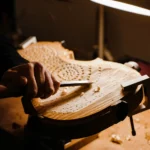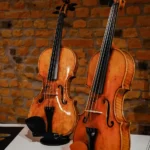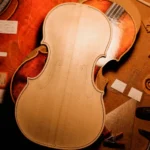The History of Cremona Italian Violin Making
Back to BlogThe History Of Cremona Italian Violin Making
The violin has a fascinating history that dates back to ancient stringed instruments like the rebec and the lyra. Typically, these instruments had a rectangular body and were often fitted with three to five strings. Over time, various enhancements were implemented to improve the quality of the instrument’s sound and make it easier to play.
Cremona is renowned for its unique contribution to classical Italian violin making, a craft with deep historical roots and still encased in mystery. Cremona is uniquely positioned in violin making, not solely because of its longstanding and esteemed craftsman tradition. Other towns can also boast a similar, if not longer, history in this field. On the contrary, Cremona stands out due to its early mastery of violin making, which had a lasting influence on the industry.
Let’s delve into the intricacies and explore the fascinating history of Italian violin-making.
The History of Cremona Italian Violin Making
Italy has a rich history of violin making, with the city of Cremona being a significant hub for this craft. Italian violin makers, particularly those originating from Cremona, played a crucial role in shaping and perfecting the modern violin.
The art of violin making in Cremona represents the pinnacle of Italian violin craftsmanship during its classic Cremonese era.
Cremona
Located in the northern region of Italy, Cremona became renowned during the 16th and 17th centuries for its exceptional craftsmanship in violin making. The city had a proud history of world-famous violin makers, including the Amati, Guarneri, and Stradivari families, who called it home.
Amati Family
The Amati family, specifically Andrea Amati (1505-1577), significantly impacted the initial evolution of the violin. Andrea Amati is widely acknowledged as the pioneer of the modern violin, with many experts crediting him with its development. He is famous for crafting some of the earliest violins, which closely resemble today’s instruments. His designs established the benchmark for future violin makers.
Stradivari
Most people agree that Antonio Stradivari (1644–1737), better known by his stage name Stradivarius, was the most famous violin maker in history. His skilled craftsmanship and meticulous attention to detail resulted in instruments with exceptional tone qualities and unparalleled visual appeal. Violins made by Antonio Stradivari are highly sought after and fetch extremely high auction and private sales prices.
Guarneri Family
The Guarneri family, including the most famous Bartolomeo Giuseppe Guarneri (del Gesù) (1698-1744), produced violins considered equal in sound quality to those of Stradivari. Guarneri del Gesù’s violins are known for their powerful and intense sound, often preferred by musicians seeking a darker, richer tone.
Regional Traditions
The violin-making traditions of Cremona weren’t the only ones that flourished throughout Italy. Unique to each location, great violins were made by master luthiers in Brescia, Milan, Venice, and Naples.
Materials and Methods
Italian violin makers were well known for their outstanding quality and selection of premium materials. They experimented with different kinds of wood, using maple for the back, ribs, and neck and spruce for the top plate. They also developed techniques for varnish application and sound modification to improve the instrument’s tonal characteristics.
Impact on the Craft
Italian violin makers played a significant role in the global evolution of violin making. Thanks to their groundbreaking work, luthiers in Europe and beyond began crafting instruments and performing with exceptional skill.
Legacy
The craftsmanship of Italian violin makers, particularly those from Cremona, remains highly esteemed and in great demand. These violins are highly regarded as some of the best crafted, attracting the attention of professional violinists and collectors who dream of owning and playing these remarkable instruments.
The rich heritage of violin-making in Italy, specifically in Cremona, has had a lasting impact on the craft, and its influence continues to be significant in the violin-making community.
How Did Cremona Become Italy’s Violin Capital?
Cremona, a charming city in the northern region of Lombardy, has just 70,000 residents. However, over 150 skilled craftsmen in this area specialize in creating string instruments, particularly violins, violas, and cellos.
Therefore, it is a significant center for luthiers who specialize in crafting violins and string instruments. These esteemed artisans’ invaluable expertise and time-honored methods have been handed down through the ages. As a result, Cremona has earned a well-deserved spot on the prestigious UNESCO Intangible Cultural Heritage list since 2012.
Throughout history, it has served as a diocese and an independent commune. At first, it supported Emperor Frederick I Barbarossa during his clash with the Lombards due to its hatred towards Milan. However, in due course, it decided to align itself with the Lombard League, an alliance of towns in northern Italy, in 1167. The Visconti family and later the Sforzas of Milan controlled it from 1334 to 1535, except when it was under Venetian rule from 1499 to 1509. It transitioned to Spanish rule in 1535 and came under Austrian control in 1707.
This historic city in the northern region of Lombardy is known as the global hub of violin-making. It has been graced by renowned musicians and composers like Claudio Monteverdi, Amilcare Ponchielli, and Alessandro Stradella, who dedicated many of their compositions to the violin.
When you visit Piazza del Comune, you’ll be captivated by the city’s iconic landmarks: the impressive Duomo (cathedral) with its towering Torrazzo (bell tower) – a valid symbol of the town, the elegant Baptistery, and the grand Palazzo del Comune. Additionally, two other palaces in this area showcase the Renaissance style: the Fodri and Raimondi Palaces.
Famous Cremonese Violin Makers
Italian luthiers have gained global recognition for their exceptional craftsmanship and the production of top-notch stringed instruments. Throughout history, skilled artisans from Italy, including renowned names like Antonio Stradivari, Giuseppe Guarneri del Gesù, and Andrea Amati, have established themselves as masters in creating exceptional violins, violas, and cellos. These instruments are highly sought after for their exquisite sound and stunning aesthetics, as well as their rich historical importance and potential for increasing in value over time. The renowned Italian violin makers in Cremona have profoundly impacted the world of music.
Let’s take a look at some of the most famous violin makers in the history of Italian violin-making:
Andrea Amati
Andrea Amati is widely recognized as the pioneer of violin-making in the Cremonese school. He belonged to the Amati family, a renowned lineage of luthiers credited with significant violin-making advancements. Violin-making traces back to the 15th century when Andrea Amati began crafting these exquisite instruments. His exceptional craftsmanship was pivotal in shaping the renowned Cremonese style of violin making.
Francesco Ruggeri
Francesco Ruggeri, a notable figure in the early days of violin-making in Cremona, left a lasting impact on the industry. He lived in the same era as Nicolò Amati (Andrea’s grandson) and is thought to have learned his craft from him.
Antonio Stradivari
Antonio Stradivari is widely regarded as the most exceptional violin maker in history. His reputation as a master of violin craftsmanship soared during his impressive life in Cremona (1644–1737). Because of their exceptional scarcity, exquisite sound quality, and impeccable artistry, the violins he creates command some of the highest costs in the global market.
Giueppe Guarneri del Gesù
Giuseppe Guarneri del Gesù, a renowned violin maker from Cremona, crafted exquisite instruments during the 18th century. The Guarneri family has a remarkable legacy in Italian violin-making, spanning centuries and originating in 17th-century Cremona. His instruments are held in such high esteem that they are often compared to those crafted by Antonio Stradivari.
The Rebirth of Cremona’s Violin Tradition
Cremona has established itself as a global center for violin production, boasting a thriving community of over a hundred workshops. Renowned figures in modern art history include Francesco Bissolotti and G.B. Morassi. Artisans worldwide gather in Cremona every three years for the highly esteemed Triennial Instrument Making Competition. Cremona is strongly dedicated to preserving the violin and its rich history, as it is the city where this iconic instrument originated.
The past of making violins in Cremona, Italy, shows how tradition, new ideas, and expertise can work together delicately. From the old workshops in Cremona to modern lutherie worldwide, the art has changed over time, adding new technology while still honoring its rich history. Today’s luthiers are inspired by famous craftsmen like Stradivari and continue to push the limits of what is possible with wood and bow.
To find out more about violins, visit Amorim Fine Violins. You can also discover exciting stories about the violin’s past and care and performance tips. Whether you’re a player or just interested, our website has helpful information to help you on your violin journey.









